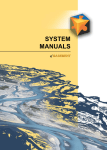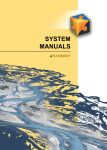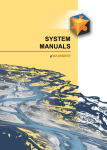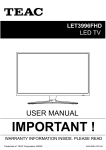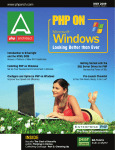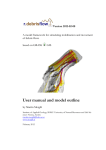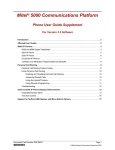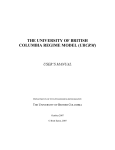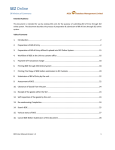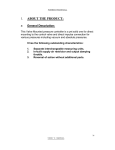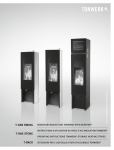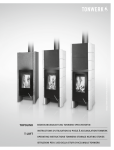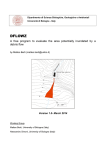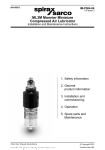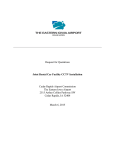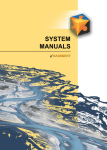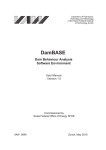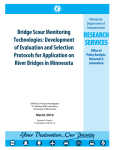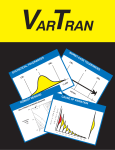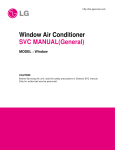Download Preface to Version 2.0 - Basement
Transcript
SYSTEM MANUALS o fBASEMENT System Manuals BASEMENT This page has been intentionally left blank. VAW ETH Zürich System Manuals of BASEMENT CREDITS VERSION 2.5.2 August, 2015 Project Team Software Development, Documentation and Test (alphabetical) D. Ehrbar, MSc. ETH Civil Eng. M. Facchini, MSc. Environmental Eng. M. Gerber, BSc. Software Eng. S. Kammerer, MSc. ETH Environmental Eng. S. Peter, MSc. ETH Civil Eng. L. Vonwiller, MSc. ETH Environmental Eng. Project Supervisor Dr. D. Vetsch, Dipl. Ing. ETH Scientific Advisor Dr. A. Siviglia, MSc Director VAW Prof. Dr. R. Boes Art Design and Layout: W. Thürig, D. Vetsch Former Project Members em. Prof. Dr.-Ing. H.-E. Minor, Director of VAW 1998-2008 Dr. R. Fäh, Dipl. Ing. ETH, Scientific Supervisor, 2002-2013 Dr.-Ing. D. Farshi, MSc., Software Development, 2002-2007 Dr. R. Veprek, Dipl. Rech. Wiss. ETH, Software Development, 2009-2010 R. Müller, Dipl. Ing. EPFL, Software Development, 2003-2012 P. Rousselot, Dipl. Rech. Wiss. ETH, Software Development, 2006-2014 Dr. C. Volz, Dipl.-Ing. Umwelttechnik, Software Development, 2007-2015 Commissioned and co-financed by Swiss Federal Office for the Environment (FOEN) Contact [email protected] http://www.basement.ethz.ch © 2006–2015 ETH Zurich, VAW Vetsch D., Siviglia A., Ehrbar D., Facchini M., Gerber M., Kammerer S., Peter S., Vonwiller L., Volz C., Farshi D., Mueller R., Rousselot P., Veprek R., Faeh R. VAW ETH Zürich Version 8/12/2015 System Manuals of BASEMENT CREDITS Citation Advice For System Manuals: Vetsch D., Siviglia A., Ehrbar D., Facchini M., Gerber M., Kammerer S., Peter S., Vonwiller L., Volz C., Farshi D., Mueller R., Rousselot P., Veprek R., Faeh R. 2015. System Manuals of BASEMENT, Version 2.5. Laboratory of Hydraulics, Glaciology and Hydrology (VAW). ETH Zurich. Available from <http://www.basement.ethz.ch>. [date of access]. For Website: BASEMENT – Basic Simulation Environment for Computation of Environmental Flow and Natural Hazard Simulation, 2015. http://www.basement.ethz.ch For Software: BASEMENT – Basic Simulation Environment for Computation of Environmental Flow and Natural Hazard Simulation. Version 2.5. © ETH Zurich, VAW, Vetsch D., Siviglia A., Ehrbar D., Facchini M., Gerber M., Kammerer S., Peter S., Vonwiller L., Volz C., Farshi D., Mueller R., Rousselot P., Veprek R., Faeh R., 2006-2015. VAW ETH Zürich Version 8/12/2015 System Manuals of BASEMENT PREFACE Preface to Versions 1.0 – 1.3 The development of computer programs for solving demanding hydraulic or hydrological problems has an almost thirty-year tradition at VAW. Many projects have been carried out with the application of “home-made” numerical codes and were successfully finished. The according software development and its applications were primarily promoted by the individual initiative of scientific associates of VAW and financed by federal instances or the private sector. Most often, the programs were tailored for a specific application and adapted to fulfil costumer needs. Consequently, the software grew in functionality but with little documentation. Due to limited temporal and personal resources to absolve an according project, a single point of knowledge concerning the details of the software was inevitable in most of the cases. In 2002, the applied numerics group of VAW was invited by the Swiss federal office for water and geology (BWG, nowadays Swiss Federal Office for the Environment FOEN) to offer for participation in the trans-disciplinary “Rhone-Thur” project. With the idea to build up a new software tool based on the knowledge gained by former numerical codes - while eliminating their shortcomings and expanding their functionality - a proposal was submitted. The bidding being successful a partnership in terms of co-financing was established. By the end of 2002, a newly formed team took up the work to build the so-called “BASic EnvironMENT for simulation of environmental flow and natural hazard simulation – BASEMENT”. From the beginning, the objectives for the new project were ambitious: developing a software system from scratch, containing all the experience of many years as well as state-of-the-art numerics with general applicability and providing the ability to simulate sediment transport. Additionally, professional documentation is a must. As to meet all these demands, a part wise reengineering of existing codes (Floris, 2dmb) has been carried out, while merging it with modern and new numerical approaches. From a software-technical point of view, an object-oriented approach has been chosen, with the aim to provide reusability, reliability, robustness, extensibility and maintainability of the software to be developed. After four years of designing, implementing and testing, the software system BASEMENT has reached a state to go public. The documentation at hand confirms the invested diligence to create a transparent software system of high quality. The software, in terms of an executable computer program, and its documentation are available free of charge. It can be used by anyone who wants to run numerical simulations of rivers and sediment transport – either for training or for commercial purposes. VAW ETH Zürich Version 9/5/2014 System Manuals of BASEMENT PREFACE The further development of the software tends to new approaches for sediment transport simulation, carried out within the scope of scientific studies on one hand side. On the other hand, effectiveness and composite modelling are the goals. On either side, a reliable software system BASEMENT will have to meet expectations of the practical engineer and the scientist at the same time. em. Prof. Dr.-Ing. H.-E. Minor Member of the steering committee of Rhone-Thur Project 2002-2007 Director of VAW, 1998-2008 October, 2006 VAW ETH Zürich Version 9/5/2014 System Manuals of BASEMENT PREFACE Preface to Versions 1.4 The work since the first release of the software in October 2006 was exciting and challenging. To go public is paired with interests and demands of users – although user support for the software never was intended. But interchange with users is definitely one of the most crucial factors of successful software development. Feedback from academic or professional users conveys a different point of view and enables the development team to achieve costumer proximity as well as to consolidate experience. Accordingly, the project team tried to meet the demands as effectively as possible. In version 1.3 of BASEMENT, which was released in April 2007, there were some errors fixed, a few new features added and the documentation was completed. Since then, many things have changed: on the personnel, on the project as well as on the software technical level. In summer 2007 one of our main software developers, Dr. Davood Farshi, left VAW and changed to an international hydraulic consultant. Dr. Farshi supported our team from 2002 to 2007 as a profound numeric specialist and was mainly involved in the development of BASEplane. At his own request, he is still engaged in the development of BASEMENT as external advisor and tester. Dr. Farshi’s position in the project team was reoccupied by Christian Volz, an environmental engineer from southern Germany. Mr. Volz has broad experience in numerical modelling as well as object-oriented programming. On the project level the framework slightly changed. The initial scope within BASEMENT was developed, the “Rhone-Thur” project, has been finalized by the end of 2007. The sequel is called “Integrales Flussgebietsmanagement”. It has the same co-financer as its predecessor, namely the Swiss federal office for the environment (FOEN), and basically the same participating institutions (EAWAG, WSL, LCH(EPFL) and VAW(ETHZ)). The funding runs until the end of 2011. Due to the retirement of Prof. Dr.-Ing. H.-E. Minor in summer 2008, our laboratory is solely represented in the project committee by Dr. R. Fäh at the moment. The emphases of the new proposal for the further development of BASEMENT are advanced topics of hydraulics and sediment transport, such as secondary currents and lateral erosion. Furthermore, the efficiency of the software should be increased by the implementation of appropriate parallelisation and coupling approaches. Since the last minor release a long time passed, which was mainly consumed by a general revision of the software. After five years of development a diligent consolidation was expedient. In addition, the coincidence of a new team member offered an unbiased reflection of the source code. All in all it was very worthwhile. Last but not least, there are numerous bugs fixed and some new features in the current version. Mainly the efficiency of the software has been improved. The first stage of parallelisation is completed. The current implementation of the code includes the OpenMP interface which allows for parallel execution of the basic computation loops. In other words, the software is now able to exploit the power of current multi-core processors with a VAW ETH Zürich Version 9/5/2014 System Manuals of BASEMENT PREFACE convincing speedup. Furthermore, the revision of some data structures and output routines as well as the application of an optimised compiler led to a reduction in execution time. Concerning sediment transport, the one-dimensional model BASEchain now supports the modelling of fine material, either as suspended or bed load. Also the advanced models for boundary conditions are worth mentioning. On the one hand, it is now possible to model domain boundaries with momentum and on the other hand, special boundary conditions inside the computational region, such as a weir or a gate, are implemented. The fact, that the version 1.4 of BASEMENT is also available for the Linux operating system the first time, rounds off the new additions and features of the software package at hand. Summarised one may say that the release 1.4 of BASEMENT is a major release due to all the different kinds of changes, but it’s still a minor release concerning the new features – let’s call it a “major minor” release. We are looking forward to Version 2.0 of BASEMENT, which is planned for next year. D. Vetsch Project Supervisor October, 2008 VAW ETH Zürich Version 9/5/2014 System Manuals of BASEMENT PREFACE Preface to Version 2.0 Four years ago, in spring 2006, the first version of the software system BASEMENT was completed and ready for internal use. In autumn of the same year, the first official version 1.1 of the software was released and made available as free download on the project website www.basement.ethz.ch. Since then, the functionality of the program has been enhanced and the international user community has grown gradually. Over the last years, BASEMENT has become a reliable tool for professional investigations, especially within the scope of flood prevention, and for scientific studies. Furthermore, the software is part and parcel of the lecture “Numerical Models in Hydraulic Engineering” to ensure education of young engineers in the field of hydrodynamic numerical simulation. The lecture is held on a regular basis by VAW staff for master students of civil and environmental engineering at ETH Zurich. In February 2009, I have become the successor of Prof. em. Dr.-Ing. H.-E. Minor as Director of the Laboratory of Hydraulics, Hydrology and Glaciology (VAW) at ETH Zurich. In the meantime, I have joined the project committee “Integrales Flussgebietsmanagement”as a further representative of VAW besides Dr. R. Faeh. Furthermore, there are some changes concerning the personnel of the project team of BASEMENT to mention. Lukas Vonwiller joined the team last autumn after having obtained his master’s degree at ETH Zurich. Within the scope of his master thesis at the VAW, he studied the hydrodynamics and ecological impact of floods at the river Flaz using BASEMENT. Some of his experiences with the application of BASEMENT and selected results are documented in the new tutorial on 2-D simulations in the user manual UIV. His current duties are the application and testing of the software in terms of project work. We were also very lucky being able to engage Dr. Ratko Veprek as a distinguished software engineer for a limited period of time. His contributions to the software, such as flow control of river systems, computational efficiency and the graphical user interface, just to name a few, are of great value. Unfortunately he will leave us by the day of the release to take on a post doctoral position abroad. According to the announcement in the preface to version 1.4, the second major version of BASEMENT is released with little delay but with all the more important improvements and substantial new features. First of all, the new version 2.0 of the program comes with a graphical user interface (GUI), which allows running or stopping simulations and tracking the progress. Furthermore, the model setup and configuration, i.e. the assembling of the command file, is completely integrated into the GUI. The user is guided through the setup and any input is validated directly. In addition, the integrated help function, which is based on the command file reference, provides detailed information on the meaning of input parameters. This gives way to a clearer model setup compared to the rather fault-prone manual text editing, which is still available and also accessible through the GUI. Another main feature of the new GUI is the editing of the topography for BASEchain. Besides the GUI based setup, interpolation and thinning out of model cross sections, a graphical viewer helps the user to check the configuration and subdivision. For this reason, the new version of VAW ETH Zürich Version 9/5/2014 System Manuals of BASEMENT PREFACE BASEMENT comes with its own topography file format for BASEchain. The new format has a clear structure similar to the style of the command file. Moreover, the visualisation of actual results during a simulation with BASEviz has been improved and is now more interactive, i.e. the simulation can be paused, continued or the variable shown can be switched. Other improvements concern computational efficiency and sediment transport, especially gravitational bed load transport. Please refer to the release notes in the section “introduction and installation” of this manual for further details about new features and bug fixes. The software system BASEMENT in its current version 2.0 has reached the point to be termed as a state of the art numerical modelling tool for flow and sediment transport in rivers. The incorporated well established or new numerical approaches, software technical features like parallelization or the coupling of sub domains, advanced features for sediment transport and flow control are making it a reliable tool for professional as well as scientific applications. With the new GUI another hurdle has been cleared and a new era of the software in terms of usability has begun. We are looking forward to the further development as well as upcoming releases of BASEMENT and we are curious about how the software will establish itself in the future. Prof. Dr. R. Boes Committee Member of Project “Integrales Flussgebietsmanagement” Director of VAW May, 2010 VAW ETH Zürich Version 9/5/2014 System Manuals of BASEMENT LICENSE AGREEMENT BASEMENT SOFTWARE LICENSE between ETH Zurich Rämistrasse 101 8092 Zürich Represented by Prof. Dr. Robert Boes VAW (Licensor) and Licensee 1. Definition of the Software The Software system BASEMENT is composed of the executable (binary) file BASEMENT and its documentation files (System Manuals), together herein after referred to as “Software”. Not included is the source code. Its purpose is the simulation of water flow, sediment and pollutant transport and according interaction in consideration of movable boundaries and morphological changes. 2. License of ETH Zurich ETH Zurich hereby grants a single, non-exclusive, world-wide, royalty-free license to use Software to the licensee subject to all the terms and conditions of this Agreement. 3. The scope of the license a. Use The licensee may use the Software: - according to the intended purpose of the Software as defined in provision 1 - by the licensee and his employees - for commercial and non-commercial purposes The generation of essential temporary backups is allowed. b. Reproduction / Modification Neither reproduction (other than plain backup copies) nor modification is permitted with the following exceptions: Decoding according to article 21 URG [Bundesgesetz über das Urheberrecht, SR 231.1) If the licensee intends to access the program with other interoperative programs according to article 21 URG, he is to contact licensor explaining his requirement. If the licensor neither provides according support for the interoperative programs nor makes the necessary source code available within 30 days, licensee is entitled, after reminding the licensor once, to obtain the information for the above mentioned intentions by source code generation through decompilation. c. Adaptation On his own risk, the licensee has the right to parameterize the Software or to access the Software with interoperable programs within the aforementioned scope of the licence. d. Distribution of Software to sub licensees Licensee may transfer this Software in its original form to sub licensees. Sub licensees have to agree to all terms and conditions of this Agreement. It is prohibited to impose any further restrictions on the sub licensees’ exercise of the rights granted herein. No fees may be charged for use, reproduction, modification or distribution of this Software, neither in unmodified nor incorporated forms, with the exception of a fee for the physical act of transferring a copy or for an additional warranty protection. 4. Obligations of licensee a. Copyright Notice Software as well as interactively generated output must conspicuously and appropriately quote the following copyright notices: Copyright by ETH Zurich, VAW, 2006-2015 Vetsch D., Siviglia A., Ehrbar D., Facchini M., Gerber M., Kammerer S., Peter S., Vonwiller L., Volz C., Farshi D., Mueller R., Rousselot P., Veprek R., Faeh R. VAW ETH Zürich Version 4/21/2015 System Manuals of BASEMENT LICENSE AGREEMENT 5. Intellectual property and other rights The licensee obtains all rights granted in this Agreement and retains all rights to results from the use of the Software. Ownership, intellectual property rights and all other rights in and to the Software shall remain with ETH Zurich (licensor). 6. Installation, maintenance, support, upgrades or new releases a. Installation The licensee may download the Software from the web page http://www.basement.ethz.ch or access it from the distributed CD. b. Maintenance, support, upgrades or new releases ETH Zurich doesn’t have any obligation of maintenance, support, upgrades or new releases, and disclaims all costs associated with service, repair or correction. 7. Warranty ETH Zurich does not make any warranty concerning the: - warranty of merchantability, satisfactory quality and fitness for a particular purpose - warranty of accuracy of results, of the quality and performance of the Software; - warranty of noninfringement of intellectual property rights of third parties. 8. Liability ETH Zurich disclaims all liabilities. ETH Zurich shall not have any liability for any direct or indirect damage except for the provisions of the applicable law (article 100 OR [Schweizerisches Obligationenrecht]). 9. Termination This Agreement may be terminated by ETH Zurich at any time, in case of a fundamental breach of the provisions of this Agreement by the licensee. 10. No transfer of rights and duties Rights and duties derived from this Agreement shall not be transferred to third parties without the written acceptance of the licensor. In particular, the Software cannot be sold, licensed or rented out to third parties by the licensee. 11. No implied grant of rights The parties shall not infer from this Agreement any other rights, including licenses, than those that are explicitly stated herein. 12. Severability If any provisions of this Agreement will become invalid or unenforceable, such invalidity or enforceability shall not affect the other provisions of Agreement. These shall remain in full force and effect, provided that the basic intent of the parties is preserved. The parties will in good faith negotiate substitute provisions to replace invalid or unenforceable provisions which reflect the original intentions of the parties as closely as possible and maintain the economic balance between the parties. 13. Applicable law This Agreement as well as any and all matters arising out of it shall exclusively be governed by and interpreted in accordance with the laws of Switzerland, excluding its principles of conflict of laws. 14. Jurisdiction If any dispute, controversy or difference arises between the Parties in connection with this Agreement, the parties shall first attempt to settle it amicably. Should settlement not be achieved, the Courts of Zurich-City shall have exclusive jurisdiction. This provision shall only apply to licenses between ETH Zurich and foreign licensees By using this software you indicate your acceptance. (License version: 2015-04-21) VAW ETH Zürich Version 4/21/2015 System Manuals of BASEMENT LICENSE AGREEMENT THIRD PARTY SOFTWARE COPYRIGHT NOTICES The Visualization Toolkit (VTK) Copyright (c) 1993-2008 Ken Martin, Will Schroeder, Bill Lorensen. All rights reserved. Redistribution and use in source and binary forms, with or without modification, are permitted provided that the following conditions are met: - Redistributions of source code must retain the above copyright notice, this list of conditions and the following disclaimer. - Redistributions in binary form must reproduce the above copyright notice, this list of conditions and the following disclaimer in the documentation and/or other materials provided with the distribution. - Neither name of Ken Martin, Will Schroeder, or Bill Lorensen nor the names of any contributors may be used to endorse or promote products derived from this software without specific prior written permission. THIS SOFTWARE IS PROVIDED BY THE COPYRIGHT HOLDERS AND CONTRIBUTORS ``AS IS'' AND ANY EXPRESS OR IMPLIED WARRANTIES, INCLUDING, BUT NOT LIMITED TO, THE IMPLIED WARRANTIES OF MERCHANTABILITY AND FITNESS FOR A PARTICULAR PURPOSE ARE DISCLAIMED. IN NO EVENT SHALL THE AUTHORS OR CONTRIBUTORS BE LIABLE FOR ANY DIRECT, INDIRECT, INCIDENTAL, SPECIAL, EXEMPLARY, OR CONSEQUENTIAL DAMAGES (INCLUDING, BUT NOT LIMITED TO, PROCUREMENT OF SUBSTITUTE GOODS OR SERVICES; LOSS OF USE, DATA, OR PROFITS; OR BUSINESS INTERRUPTION) HOWEVER CAUSED AND ON ANY THEORY OF LIABILITY, WHETHER IN CONTRACT, STRICT LIABILITY, OR TORT (INCLUDING NEGLIGENCE OR OTHERWISE) ARISING IN ANY WAY OUT OF THE USE OF THIS SOFTWARE, EVEN IF ADVISED OF THE POSSIBILITY OF SUCH DAMAGE. CVM Class Library Copyright (c) 1992-2010 Sergei Nikolaev Boost Software License - Version 1.0 - August 17th, 2003 Permission is hereby granted, free of charge, to any person or organization obtaining a copy of the software and accompanying documentation covered by this license (the "Software") to use, reproduce, display, distribute, execute, and transmit the Software, and to prepare derivative works of the Software, and to permit third-parties to whom the Software is furnished to do so, all subject to the following: The copyright notices in the Software and this entire statement, including the above license grant, this restriction and the following disclaimer, must be included in all copies of the Software, in whole or in part, and all derivative works of the Software, unless such copies or derivative works are solely in the form of machine-executable object code generated by a source language processor. THE SOFTWARE IS PROVIDED "AS IS", WITHOUT WARRANTY OF ANY KIND, EXPRESS OR IMPLIED, INCLUDING BUT NOT LIMITED TO THE WARRANTIES OF MERCHANTABILITY, FITNESS FOR A PARTICULAR PURPOSE, TITLE AND NON-INFRINGEMENT. IN NO EVENT SHALL THE COPYRIGHT HOLDERS OR ANYONE DISTRIBUTING THE SOFTWARE BE LIABLE FOR ANY DAMAGES OR OTHER LIABILITY, WHETHER IN CONTRACT, TORT OR OTHERWISE, ARISING FROM, OUT OF OR IN CONNECTION WITH THE SOFTWARE OR THE USE OR OTHER DEALINGS IN THE SOFTWARE. VAW ETH Zürich Version 4/21/2015 System Manuals of BASEMENT LICENSE AGREEMENT Qt Toolkit - Cross-platform application and UI framework The Qt Toolkit is Copyright (C) 2015 Digia Plc and/or its subsidiary(-ies) and other contributors. Contact: http://www.qt-project.org/legal This library is free software; you can redistribute it and/or modify it under the terms of the GNU Lesser General Public License as published by the Free Software Foundation; either version 2.1 of the License, or (at your option) any later version. This library is distributed in the hope that it will be useful, but WITHOUT ANY WARRANTY; without even the implied warranty of MERCHANTABILITY or FITNESS FOR A PARTICULAR PURPOSE. See the GNU Lesser General Public License for more details. You should have received a copy of the GNU Lesser General Public License along with this library; if not, write to the Free Software Foundation, Inc., 51 Franklin Street, Fifth Floor, Boston, MA 02110-1301 USA Qwt - Qt Widgets for Technical Applications BASEMENT is based in part on the work of the Qwt project (http://qwt.sf.net). CGNS – CFD General Notation System cgnslib 4.5 - http://cgns.sourceforge.net VAW ETH Zürich Version 4/21/2015 System Manuals BASEMENT This page has been intentionally left blank. VAW ETH Zürich System Manuals BASEMENT INTRODUCTION AND INSTALLATION Table of Contents 1 Summary of Contents 1.1 1.2 2 Introduction ....................................................................................................... 1.1-1 Summary of the User and Reference Manual ................................................ 1.2-1 Setup and First Start 2.1 System Requirements ...................................................................................... 2.1-1 2.1.1 Microsoft Windows ...................................................................................... 2.1-1 2.1.2 Linux ............................................................................................................ 2.1-1 2.1.3 Hardware Configuration............................................................................... 2.1-2 2.2 Installing under Windows ................................................................................ 2.2-1 2.2.1 Getting the binaries ..................................................................................... 2.2-1 2.2.2 Installation procedure .................................................................................. 2.2-1 2.3 Running BASEMENT on Microsoft Windows ................................................. 2.3-1 2.3.1 Running BASEMENT using the Graphical User Interface ........................... 2.3-1 2.3.2 Running BASEMENT on the Console ......................................................... 2.3-3 2.4 Installing under LINUX ..................................................................................... 2.4-1 2.4.1 Getting the binaries ..................................................................................... 2.4-1 2.4.2 Installation procedure .................................................................................. 2.4-1 2.5 Running BASEMENT on LINUX ....................................................................... 2.5-1 3 Release Notes 3.1 Version 1.3 ........................................................................................................ 3.1-1 3.2 Version 1.4 ........................................................................................................ 3.2-1 3.3 Version 1.5 ........................................................................................................ 3.3-1 3.4 Version 1.6 ........................................................................................................ 3.4-1 3.5 Version 1.7 ........................................................................................................ 3.5-1 3.6 Version 2.0 ........................................................................................................ 3.6-1 3.7 Version 2.1 ........................................................................................................ 3.7-1 3.8 Version 2.2 ........................................................................................................ 3.8-1 3.9 Version 2.3 ........................................................................................................ 3.9-1 3.10 Version 2.4 ...................................................................................................... 3.10-1 3.11 Version 2.5 ...................................................................................................... 3.11-1 3.11.1 Version 2.5.1 ............................................................................................. 3.11-2 3.11.2 Version 2.5.2 ............................................................................................. 3.11-2 4 Features of Current Version 4.1 4.2 4.3 Subsystem BASEchain .................................................................................... 4.1-1 Subsystem BASEplane .................................................................................... 4.2-1 Subsystem BASEsub ....................................................................................... 4.3-1 VAW ETH Zürich Version 8/12/2015 i System Manuals BASEMENT INTRODUCTION AND INSTALLATION This page has been intentionally left blank. ii VAW ETH Zürich Version 8/12/2015 System Manuals BASEMENT INTRODUCTION AND INSTALLATION 1 Summary of Contents 1.1 Introduction The intention of the BASEMENT system manual is to guide and support the user in carrying out numerical simulations with BASEMENT. The documentation, in particular the introductory and theoretical chapter, shall provide a deeper insight into the implemented numerical models, their application and according preparation of necessary input data. As a matter of fact, the application of state-of-the-art numerical models for channel flow, flood plain and natural hazard simulation is a demanding task. For this reason and despite of its incompleteness, this manual should provide helpful information to gain satisfying simulation results in terms of quality and time. The BASEMENT system manuals are made up of three main parts – the user manual (denoted by the letter “U”), the reference manual (letter “R”) available as CD-ROM or download package. The parts, like the “Introduction and Installation” and the “Appendix and Index” are self-explaining. In the following, a short description of each main part is given. If you are familiar with the application of numerical models as implemented in BASEMENT, the chapters “U III: Graphical User Interface”. “UIV: Tutorials” and the documentation files will be of interest to you most of all. VAW ETH Zürich Version 8/12/2015 1.1-1 System Manuals BASEMENT INTRODUCTION AND INSTALLATION This page has been intentionally left blank. 1.1-2 VAW ETH Zürich Version 8/12/2015 System Manuals BASEMENT 1.2 INTRODUCTION AND INSTALLATION Summary of the User and Reference Manual U I – IV : USER MANUAL The user manual mainly gives an introduction to the basic simulation environment and its application. All necessary input data and its preparation are discussed. The procedure to setup a running model and the command file, which strictly defines a scenario to be simulated, are described in detail herein. U I : The Basic Simulation Environment The first part of the user manual describes the basic concepts and the components of the software system BASEMENT and gives a general introduction to its application. Get into it and learn more about the meaning of “BASEchain” and “BASEplane”. U II : Pre Processing The careful preparation of input data, such as topographical data or a discharge hydrograph of a flood event, is crucial for the scope and the quality of the result of numerical simulations. This chapter provides basic information on how to obtain and prepare the necessary input data for the models. If you don’t understand the terms “aspect ratio” or “SMS”, this chapter is worth reading. U III : Graphical User Interfance After the preparation of all input data, a simulation has to be setup. By the use of a command file, all necessary simulation parameters have to be set and the input data is linked therein. The command file can be viewed and edited using a graphical user interface (GUI). This chapter explains the usage of the GUI and its features. U IV : Tutorials This chapter guides the user through the necessary steps to setup a numerical model up working by example. With good reason, the chosen case studies are demanding in setup and application. This part of the manual lives with your experience! The development team of BASEMENT is looking forward to enrich the tutorials section with your suggestions and practical know-how. VAW ETH Zürich Version 8/12/2015 1.2-1 System Manuals BASEMENT INTRODUCTION AND INSTALLATION R I – IV : REFERENCE MANUAL On the one hand, the reference manual covers the theoretical part of the implemented models of the software system BASEMENT. On the other hand, the detail syntax description of the input files, especially the command file, is given in this section of the manual – maybe the most important part for a proficient user of BASEMENT. R I : Mathematical Models The implemented models for water flow and sediment transport are either physical conservation laws, such as the shallow water or Saint Venant equations, or empirically based balance equations, all in the form of partial differential equations. This chapter shows the so-called “governing equations” which constitute the available simulation models. To correctly describe the mathematically problem, the necessary boundary conditions and source terms are given also. R II : Numerics Kernel Most often governing equations for flow can’t be solved analytically for general boundary conditions. For this reason, the mathematical equations have to be discretized accordingly the desired special and temporary scale of the model. This section of the manual discusses the discretization methods, mainly the finite volume method, the explicit Euler scheme and especially the applied Riemann approach to solve the governing hyperbolic equation system. R III : Test Cases To validate the implemented numerical models and to check for their reliability, different well-known and well-documented test cases have been carried out. The models have been tested against analytical solutions and flume data. This chapter is mainly intended for experts, but also interesting for general users, who like to explore the capabilities and limits of the provided models. R IV : Command and Input Files These documents describe the elements of the command file, their syntax in detail and give many examples. Maybe this is the most significant part of the manual for the user at work. Herein one finds a description for each parameter and its causal arrangement. Also the formats of auxiliary files, such as hydrographs or topography files are discussed. Without a well-considered definition and arrangement of simulation parameters, the program may produce inconsistent results or even does not run at all. The parameter descriptions and the examples can also be accessed via the help function in the graphical user interface (GUI) for all input tags. 1.2-2 VAW ETH Zürich Version 8/12/2015 System Manuals BASEMENT INTRODUCTION AND INSTALLATION 2 Setup and First Start 2.1 System Requirements 2.1.1 Microsoft Windows BASEMENT is available for the following MS Windows systems: - Windows Vista Windows 7 Releases are only tested on Windows XP. According to reports from users of earlier releases, BASEMENT also runs on Windows 7, Windows Vista and Windows 2000. BASEMENT needs the following third party software to be installed: - .NET Framework 3.5 or higher - Microsoft Visual C++ 2008 SP1 Redistributable Package (x86) Both packages are freely available from Microsoft. On most machines, they are already installed because other software uses them also. For information how to get these files, please visit the FAQ on the webpage. For the latest news concerning new features and current changes, please visit the webpage. 2.1.2 Linux BASEMENT is available for the following Linux systems. The binary was compiled and tested on the following: LINUX (x86-64): - Ubuntu 12.04 (LTS), alias “Precise Pangolin”: o Kernel version 3.5.0-35 (SMP) o GNU C Library (glibc) version 2.15 o VTK-version: 5.8 - Ubuntu 14.04 (LTS), alias “Trusty Tahr”: o Kernel version 3.13 o GNU C Library (glibc) version 2.19 o VTK-version: 5.8 If you need a binary for a different version feel free to contact us. Furthermore, there is a binary without GUI and without real-time visualization (VTK). This binary should run on most (debian-based) linux systems and clusters. VAW ETH Zürich Version 8/12/2015 2.1-1 System Manuals BASEMENT 2.1.3 INTRODUCTION AND INSTALLATION Hardware Configuration We recommend the following hardware configuration: - single- or multi-core processors (x86/x86-64): o Intel (Xeon, Core 2, Pentium 4) o AMD (K7, K8, K10) - RAM: 1 GB per core - shared memory architecture Up to this moment, BASEMENT was successfully tested on 1 to 16 core Intel and AMD computers. 2.1-2 VAW ETH Zürich Version 8/12/2015 System Manuals BASEMENT 2.2 2.2.1 INTRODUCTION AND INSTALLATION Installing under Windows Getting the binaries First of all, you need to get a copy of the recent software package. You can either download the most recent version from the projects webpage (http://basement.ethz.ch) free of charge or you can order the official manual as print version including a CD and a specially illustrated ring binder using the order form on the project webpage (only production costs will be charged, approx. CHF 100). 2.2.2 Installation procedure Installation of BASEMENT from CD should start automatically if you have “autorun” enabled. Otherwise open the disk workspace and run setup.exe by double-clicking the icon. The same procedure applies, if you have downloaded the newest version from the projects webpage. Step 1 and 2: Welcome The splash screen of the installation opens up and shows the actual version to be installed. Click “next” to continue. The second window displays some warning about copyright protection. Click “next” to continue. VAW ETH Zürich Version 8/12/2015 2.2-1 System Manuals BASEMENT INTRODUCTION AND INSTALLATION Step 3: Accepting the License Agreement The next step is the license agreement – please read it carefully. By activating the “I agree” button, you accept the terms and conditions to use this software. 2.2-2 VAW ETH Zürich Version 8/12/2015 System Manuals BASEMENT INTRODUCTION AND INSTALLATION Step 4: Select the Installation Folder After accepting the License agreement, you can choose where to install the binaries. Default proposition is “C:\program files\BASEMENT”. You are free to choose any other directory. The button “Disk costs” compares your free disk space with the required space for BASEMENT. You can also choose whether BASEMENT is installed for all users on this machine or just for the active account. If the installation is desired for all users, you need to be logged in as administrator. When you finished your choice, click “next” to continue. Step 5 and 6: Confirming and Finishing the Installation This is the last chance to rethink the decision about an installation. Clicking “next” will start the installation process. After all files are copied, a final window informs about the success of the installation. Click “close” to finish the installer. VAW ETH Zürich Version 8/12/2015 2.2-3 System Manuals BASEMENT INTRODUCTION AND INSTALLATION This page has been intentionally left blank. 2.2-4 VAW ETH Zürich Version 8/12/2015 System Manuals BASEMENT 2.3 2.3.1 INTRODUCTION AND INSTALLATION Running BASEMENT on Microsoft Windows Running BASEMENT using the Graphical User Interface After having successfully installed the program, you may notice the icon for BASEMENT on your desktop: This is the Icon used for the program executable. The command files have a similar icon but are additionally identified by “CMD” within the logo. To get the icon for a command file displayed, the command file must end with “.bmc”. There are two ways to start the program. Either by clicking on the program symbol or directly by double clicking a command file (File with “.bmc” ending) for BASEMENT. Since version 2.0, BASEMENT runs as a standalone application including a simple graphical user interface (to run BASEMENT in batch mode see chapter 2.3.2): The difference between the two starting mechanisms however is simple: Starting the program by clicking the input file sets the path for the working folder and the scenarios name automatically according to the position of the input file and its content. If you just start the program by clicking the executable, you have to select the scenario by pressing the “Edit command” button, which will open the command file editor. Using this editor, you can load (“Open File”) your command file and thereby setting the working directory to the directory where the command file is located. VAW ETH Zürich Version 8/12/2015 2.3-1 System Manuals BASEMENT INTRODUCTION AND INSTALLATION Once you loaded a command file it remains the active until you load the next one or save the current one with a new name. When a command file is available to BASEMENT, the “Run” button is enabled. Pressing it starts the simulation. The console messages of BASEMENT are printed to the console view: Below the console, the progress of the simulation is shown, together with the elapsed time and a guess of the required overall time. At the lower right, the real time speedup (RTS) of the simulation is shown. The real time speed up gives the number of seconds calculated in the simulation within one real time second. All files containing the results will be saved in the working directory containing the command and auxiliary files. Further details concerning the GUI of BASEMENT are explained in the user manual UIII. Notice: The command filename must not contain any spaces or special characters like ä, ö, ü, è, etc. 2.3-2 VAW ETH Zürich Version 8/12/2015 System Manuals BASEMENT 2.3.2 INTRODUCTION AND INSTALLATION Running BASEMENT on the Console The following command line arguments are available, which can be also obtained in the command prompt (console) with the help command ‘-h’ (typing BASEMENT_vX.Y.exe -h, whereas ‘X.Y’ has to be replaced by the actual version number): -version -h -f “filename.bmc” -t -b -verbose -no_cls -log -doc : display BASEMENT version (0 args) : display help information (0 args) : name of commandfile to be executed (1 arg) : pares input file and validate for errors (combination with –f) : no user inputs required (0 args) : detailed information outputs (0 args) : no clear screen (0 args) : log level of output (1 arg, [2-6]) : output of documentation in html-format Of particular interest is the possibility to run BASEMENT in the batch mode. The batch mode is started by calling the BASEMENT executable using the -b command line switch. The command line switch -b selects the batch mode and prevents the GUI to be started. The desired command file is defined using the -f command line switch. In a batch file several simulations can be runned consecutively (for example over the weekend). To generate a batch file just create an empty text file and replace the ending ‘.txt’ by ‘.bat’. In this file several command lines can be defined as for example: "C:\Programs\Basement\BASEMENT_v2.2.1.exe" -f F:\Project_1\run.bmc -b "C:\Programs\Basement\BASEMENT_v2.2.1.exe" -f F:\Project_2\run.bmc -b "C:\Programs\Basement\BASEMENT_v2.2.1.exe" -f F:\Project_3\run.bmc –b Then run the batch file by double clicking. VAW ETH Zürich Version 8/12/2015 2.3-3 System Manuals BASEMENT INTRODUCTION AND INSTALLATION This page has been intentionally left blank. 2.3-4 VAW ETH Zürich Version 8/12/2015 System Manuals BASEMENT 2.4 2.4.1 INTRODUCTION AND INSTALLATION Installing under LINUX Getting the binaries You need to get a copy of the actual distribution as described in the Windows installation section. One can either download the most recent version from the projects webpage (http://basement.ethz.ch) or one has an official manual including a CD which can be ordered on the same webpage. 2.4.2 Installation procedure The installation of program and documentation on LINUX systems is to be done via the console. Please replace all occurrences of ‘X.Y’ in the installation introduction by the actual version number. Step 1: Preparation of the installation Before unzipping the zipped installation file you probably want to create a temporary directory (‘/tmp’) and copy the downloaded file into this directory. Change to this directory where the downloaded zip-file is located. Unzip the file by typing: unzip BASEMENT_vX.Y_linux.zip Step 2: Installation of BASEMENT and license agreement Under the unzipped files you can find an executable named ‘setup’ and an ‘install.txt’ which has additional information on the installation process. To start the installation, run setup ./setup and follow the instructions. The license text of BASEMENT is displayed and must be agreed on to proceed with the installation. After running setup the password protected zip-file is extracted and the debian package file is available. VAW ETH Zürich Version 8/12/2015 2.4-1 System Manuals BASEMENT INTRODUCTION AND INSTALLATION Step 3: Installation of debian (*.deb)-package To ease the installation of BASEMENT a debian-package is created which automatically installs all needed files, the documentation and the tutorials and test cases on the pc. To install this package administrator rights are needed. Therefore on Ubuntu the ‘sudo’ command is needed. To start installation type sudo dpkg -i basement-X.Y-XXX.deb The debian package automatically detects if your configuration misses one of the needed requirements. In such a case you can use ‘apt-get install …’ on Ubuntu systems to install the missing packages. Previous versions of basement are automatically detected by the installer and deleted before the installation starts. If the installation of the package was successful, than the binary file is copied to /usr/bin and the program files, the documentation, the test cases and the tutorial are available under /usr/share/basement 2.4-2 VAW ETH Zürich Version 8/12/2015 System Manuals BASEMENT 2.5 INTRODUCTION AND INSTALLATION Running BASEMENT on LINUX If the installation succeeded, start BASEMENT with its graphical user interface in a terminal window with a shell command prompt just by typing: basement Selecting an actual simulation, running a simulation on LINUX or using batch mode works the same way as it does on Windows (see chapter 2.3.1 and 2.3.2). Notice: The command filename must not contain any spaces or special characters like ä, ö, ü, è, etc. VAW ETH Zürich Version 8/12/2015 2.5-1 System Manuals BASEMENT INTRODUCTION AND INSTALLATION This page has been intentionally left blank. 2.5-2 VAW ETH Zürich Version 8/12/2015 System Manuals BASEMENT INTRODUCTION AND INSTALLATION 3 Release Notes 3.1 Version 1.3 Subsystem BASEdomain: A logical error check is performed between reading the input file and the start of the simulation. In case of logical errors (contradictions, missing information), the simulation will stop immediately. In any case, a file 'inputerror.err' is created, where all errors and warnings are listed for the current simulation. It is highly recommended to have a look at this file for every simulation being started. Subsystem BASEchain: - problem in computation of cross section area fixed - problem with omission of values in topography file fixed - sediment transport fixed - new output: difference of water volume - new output: difference of sediment volume - bed load formula of “Rickenmann” - output of topology of cross section not automatic any more - output of sediment mixtures not automatic any more Subsystem BASEplane: - Computation of the inlet bed load from the bed load hydrograph has been modified. - The jacobian matrix has been corrected to calculate the slopes for the quad. Elements. - The coefficient "C" for the weir calculation has been improved! - The output for the cell centres is modified. For this instead of the xyz output, a mesh file including the centres coordinates with the elements number are written. - The flux over the weir has been corrected! - The time step computation has been also extended to the boundary edges. In the previous version only the internal edges were considered for the time step computation. - A new parameter “node_elevation_method” has been added to the MorphologyParameter block. The calculation of the nodal elevation based on the “node_elevation_method” can be done with interpolation or slope method. System Manuals: - Part UIV has a new tutorial for 2-D simulations. - Part RIV and corresponding structures in UIV are completely revised. - Wrong assigned page numbers in some TOCs are corrected. - Header of part “Index / Appendix” corrected. - Update your hardcopy version with the documentation patch. VAW ETH Zürich Version 8/12/2015 3.1-1 System Manuals BASEMENT INTRODUCTION AND INSTALLATION This page has been intentionally left blank. 3.1-2 VAW ETH Zürich Version 8/12/2015 System Manuals BASEMENT 3.2 INTRODUCTION AND INSTALLATION Version 1.4 General Notice: All users working on a project with v1.3 at the moment should use v1.3 until the project ends and update for version 1.4 afterwards. Changes made to the boundary condition will lead to a slightly different behaviour of v1.4 compared to v1.3. Therefore, a calibrated scenario for v1.3 is not calibrated to work with v1.4! Subsystem BASEparse: - New command file structure allowing for distinction of bed load and suspended load in 1-D. The structure also changed in 2-D for similar reason. New structure of command file in HYDRAULICS: All friction parameters are now defined in their own block FRICTION instead of the SOURCE block as in v1.3 Attention: The changes of the command file’s structure are not backwards compatible! Input files for v1.3 will not work with v1.4 and vice versa. We recommend all users to update to version 1.4. Subsystem BASEchain: - problem with HQ-Relation stored in a file fixed problem with update of hydraulic tables after geometry change due to bed load fixed necessity for a comment for each cross section in HEC-RAS files eliminated problem with cross section names ending with one or more 0 in HEC_RAS files fixed beta values in Tecplot file are now mean values over the whole bed width instead of value of the first slice new friction type: Manning new binary Tecplot files for longitudinal profile data new binary output file for cross section topology new suspended load simulation o advection by QUICKEST scheme o advection by Holly-Preissmann scheme o advection by MDPM scheme o sediment exchange between water and bed o diffusion by given factor or internal computation VAW ETH Zürich Version 8/12/2015 3.2-1 System Manuals BASEMENT INTRODUCTION AND INSTALLATION Subsystem BASEplane: - Inner Boundary Conditions (weir and gate) implemented Weir Boundary Condition modified (velocity component in momentum equation) UCD-Output for AVS enabled (Universal Cell Data) additional friction types implemented (strickler, darcy, chezy, etc) new wall friction added to optionally consider wall friction at boundary edges hydrograph boundary redesigned with momentum flux at inflow (please use an external source if you want an inflow without momentum flux) new h-Q boundary implemented which allows the specification of a h-Q relation as outflow ascii and binary Tecplot output performance tuning of some subroutines and file outputs additional geometry check for ambiguous gradients minor bug fixes Subsystems BASEchain and BASEplane: - Parallelization for shared memory multi-core systems implemented New LINUX version prepared BASEviz visualization tool added (currently ONLY for Windows version) System Manuals: - 3.2-2 Please read the credits and the new preface, which are introducing a new team member and are giving citation advice Part UI-5: new chapter about parallel processing Part UII-3.3: some hints concerning mesh quality, especially how to deal with ambiguous elements Part UIII: almost complete revision. Examples for and comments on newly added features Part UIV: overall correction. Part RI: complete revision Part RII-2.3: treatment of inner boundaries Part RII-3.2: schemes for suspended sediment transport Part RIII: additional test cases for suspended sediment transport and parallel execution Part RIV: complete revision Update your hardcopy version with the documentation patch. VAW ETH Zürich Version 8/12/2015 System Manuals BASEMENT 3.3 INTRODUCTION AND INSTALLATION Version 1.5 General: New Features: - Batch Mode (running BASEMENT with program arguments) Subsystem BASEchain: New Features: - Source and sink of suspended load - Conservation of sediment exchange between bed and suspended load improved Bug fixes: - Wrong warning concerning friction definition eliminated Subsystem BASEplane: New Features: - Gate Boundary - HLLC Riemann solver Bug fixes: - Value Check hQ-Relation - Correction of Hydrograph boundary at supercritical flow conditions - Bug fix of edges memory reservation in case of very large grids with many holes - Vector length scaling added for the vtk velocity vector output - Prevent output of negative flow depths VAW ETH Zürich Version 8/12/2015 3.3-1 System Manuals BASEMENT INTRODUCTION AND INSTALLATION This page has been intentionally left blank. 3.3-2 VAW ETH Zürich Version 8/12/2015 System Manuals BASEMENT 3.4 INTRODUCTION AND INSTALLATION Version 1.6 Subsystem BASEchain: New Features: - Implicit solution of hydrodynamics - Smart-Jaeggi bed load formula Bug fixes: - Correction transport diagram - Conveyance computation (negative areas) Subsystem BASEplane: New Features: - Revision of sediment transport (Dual Mesh concept) - Kinematic viscosity and algebraic turbulence model - Wu bed load formula - Improved treatment of bed source terms for quadrilateral elements - New approach of slope calculation for quadrilateral elements - Improved concept of wall friction treatment - Flux correction algorithm implemented to enhance mass conservation - New outflow boundary: ZHydrograph Bug fixes: - HQ-Relation and Hydrograph boundaries System Manuals: - Part UIII: Introduction to new features Part UIV: Corrections Part RI: Complete revision and additions, e.g. sediment transport Part RII: Complete revision and additions, e.g. partially wetted elements, sediment transport, dual mesh approach and implicit time integration. Part RIII: Additions and corrections Part RIV: Documentation of new features VAW ETH Zürich Version 8/12/2015 3.4-1 System Manuals BASEMENT INTRODUCTION AND INSTALLATION This page has been intentionally left blank. 3.4-2 VAW ETH Zürich Version 8/12/2015 System Manuals BASEMENT 3.5 INTRODUCTION AND INSTALLATION Version 1.7 General: New Features: - Coupling of subsystems BASEchain and BASEplane, i.e. sub-domains - Flow control in river systems Subsystem BASEchain: New Features: - Multiple boundaries at in- and outflow cross sections - Speed improvements for explicit simulations - Improvements of zhydrograph-boundary condition - Changed behaviour of qlateral source (now uses one cross section) Bug fixes: - Batch execution mode corrected Subsystem BASEplane: New Features: - Suspension transport 2-D - Improvements of inner boundaries - New procedure for updating velocities at partially dry elements (prevention of high velocities at wet-dry interfaces) - ZHydrograph boundary condition enhanced to be used as outflow or inflow Bug fixes: - Correction of hydrograph boundary in case of no inflow - Negative area for element prevented (only occurs when .2dm is manually changed so that nodes are not counter clockwise) - Bug fixes in Tecplot output routines - Default behaviour of HQ relation changed, partially dry edges are treated as zero_gradient instead of wall System Manuals: - new chapters on model coupling and flow control additions and corrections VAW ETH Zürich Version 8/12/2015 3.5-1 System Manuals BASEMENT INTRODUCTION AND INSTALLATION This page has been intentionally left blank. 3.5-2 VAW ETH Zürich Version 8/12/2015 System Manuals BASEMENT 3.6 INTRODUCTION AND INSTALLATION Version 2.0 General: New Features: - Graphical user interface (GUI) for BASEMENT with integrated reference manual. Enables faster and correct setup of command files, setup and interpolation of BASEchain topography files and running a simulation. - Visualization (BASEviz) revised and improved to be more interactive. - Additional Q-t-Table implemented for flow control. - All sediment transport formulas can now be used for BASEchain and BASEplane. - Additional bedload transport formula implemented with Meyer-Peter Müller approach for multi-grain with critical shear stress correction according to Ashida and Michiue. Subsystem BASEparse: - Various changes and standardizations of input tags in the command file parser. Attention: The changes of the command file’s structure are not backwards compatible! Input files for v1.7 will not work with v2.0 and vice versa. We recommend all users to update to version 2.0. Guidance on how to convert old command files into the new format: There are several possibilities to update old command files. Maybe the easiest way is to use the new graphical user interface (GUI). Start the program BASEMENT and open your old command file. The message “parsing failed” will pop up and ask you to open your file in the raw editor to fix it. Confirm with the OK button. In the raw editor the parse errors will appear in the lower section in red colour. Invalid tags are pointed out and possible tags are proposed. Apply the proposed changes and click on the “Validate” button to see if your correction was successful. If some proposed tags should be unclear to you have a look at the Block List in the Reference Manual R IV. In the information-rich Block List all input blocks and possible tags are described. Another possibility is to build up a new command file with the GUI of BASEMENT. This way you will learn to use the new GUI and will be provided with all possible input blocks, tags and information. Subsystem BASEchain: New Features: - New topography format implemented for BASEchain (.bmg). Please use this file format as the default format for all new projects. - Python-script to convert files from old Floris-format to new input format. The script can be downloaded from the website and requires ‘python’ to be installed (www.python.org). VAW ETH Zürich Version 8/12/2015 3.6-1 System Manuals BASEMENT - INTRODUCTION AND INSTALLATION Tool in graphical user interface (GUI) for cross section interpolation. Tool in graphical user interface (GUI) to automatically thin out grid points and thus speed up simulations. Significant speed improvements especially for hydraulic calculations. Coupling via “off-channel” source enabled. Bug fixes: - Bug fix in Roe solver. Please note: Due to revision works, at the moment only one soil may be specified for a cross section in morphological simulations. Usage of multiple soils will be enabled again in future. Subsystem BASEplane: New Features: - New framework for data output with additional features and output variables. - Geometric approach for gravitational bed load transport (slope failures). - Some speed improvements for hydraulic calculations. - Additional sediment inflow boundary condition which sets inflow to transport capacity. - Changes in calculation of sediment fluxes. Upwind-factor now has more effect. Bug fixes: - H-Q iterations and default precision in Hydrograph boundary conditions fixed. - Bug fix in treatment of fixed bed regions based on material index. - Bug fix in deletion of layers. - Bug fix for sediment restart. - Error at simultaneous binary tecplot output of hydraulic and sediment data fixed. System Manuals: - 3.6-2 Additions and corrections. Revision of hydraulic tutorial for BASEchain. New hydraulic and sediment tutorial for BASEplane. HTML-documentation files can be automatically generated by starting BASEMENT with command line flag “-doc”. VAW ETH Zürich Version 8/12/2015 System Manuals BASEMENT 3.7 INTRODUCTION AND INSTALLATION Version 2.1 General: New Features: - Controller extended for external sources - Support of jpeg-output of BASEviz visualization (experimental) Subsystem BASEchain: New Features: - A simple consideration of internal levees - Time dependent grain mixtures as new upper boundary for bed load. - Multiple soils in one cross section are possible again, a factor is available to define from which degree of submersion a soil is considered to be wetted and will be moved. - For bed load transport the definition of the bed bottom is needed again! Bug fixes: - Transport diagram - Monitoring point integration for simulations starting after time 0. - No more elimination of elevations smaller than h dry in hydraulic balance. - Initialisation of initial_time_step. Subsystem BASEplane: New Features: - New upwind method for suspended transport - New binary restart file format (CGNS) contains all restart data and enables restart from different solution times (hydraulics, bed load and suspension) - Reduced mesh dependence in many situations due to changed formulation of Riemann problem on edges - Initial depth is set to zero over the domain (and no longer to depth_min) - Several improvements in data output (depth/wse output are consistent now, sediment balancing improved, added specific discharge, renaming of “z_bed z_element” and “zcoordz_node”) - Some speed improvements for parallel execution - Improvements and parallelization of gravitational transport Bug fixes: - Bugfix for inner gate because unphysical flux could be generated in dry cells - Bed load transport rate was determined too small in some cases ! - Bugfix of 2dm mesh input. Internal edges of last nodes of the mesh could be falsely treated as boundary edges. - Tecplot output was restricted to 6 digits, now changed to 8 digits - Bugfix in layer interpolation on sediment elements VAW ETH Zürich Version 8/12/2015 3.7-1 System Manuals BASEMENT INTRODUCTION AND INSTALLATION System Manuals: - 3.7-2 New manual for the graphical user interface (GUI) replaced old UIII manual New sediment tutorial for fractional transport for BASEplane Additions and corrections VAW ETH Zürich Version 8/12/2015 System Manuals BASEMENT 3.8 INTRODUCTION AND INSTALLATION Version 2.2 General: New Features: - External coupling implemented for data exchange with external programs over TCP/IP (experimental stage) - 64-bit linux version available for Ubuntu Natty (11.04) Subsystem BASEchain: New Features: - Account for grain abrasion due to mechanical stress after Sternberg Bug fixes: - Bugfix in layer creation for sediment transport - Bugfix in grain sorting in fractional sediment transport - Bugfix in BASEviz-output, pause-function did not work Subsystem BASEplane: New Features: - Cycle step for quasi-steady bed-load & suspension transport to speed up morphological simulations - zhydrograph boundary improved. Ghost cell velocities can be set to zero (e.g. lake) or to the upstream cell velocity (e.g. stream). - Threshold value can be set in water surface output in case of dry conditions. - Upwind-factor for bed-load transport is assigned now for each material index Bug fixes: - Correction in water balance for partially saturated elements - Bugfix in dynamic-depth solver, partially wetted cells were not treated correctly - Gravitational transport no longer requires an addtitional BEDLOAD or a SUSPENSION block to be defined - External sources for bed-load & suspension moved to MORPHOLOGY-block - INITIAL-block in MORPHOLOGY-block is now mandatory - Bugfix in output of sediment inflow at first time step - Bugfix critical shear stress of incipient motion (theta_critic) was not correctly initialized System Manuals: - Additions and corrections VAW ETH Zürich Version 8/12/2015 3.8-1 System Manuals BASEMENT INTRODUCTION AND INSTALLATION This page has been intentionally left blank. 3.8-2 VAW ETH Zürich Version 8/12/2015 System Manuals BASEMENT 3.9 INTRODUCTION AND INSTALLATION Version 2.3 General: New Features: - New pre- and post-processer BASEmesh for unstructured 2-D mesh creation, setting of material indices and visualization. Usable as plugin in the free software Quantum GIS (QGIS) on Windows and Linux. - Enhancement of lateral coupling; automatic creation of connections between 1-D cross sections and 2-D edges (experimental) Bugfixes: - Bugfix of HEC-RAS conversion script for non-georeferenced files Subsystem BASEparse - New TIMESTEP block introduced in command file - Improved documentation of controller-features - Units of sediment boundaries and sources clarified - Ranges of tag values in command file are now shown correctly - Additional warnings added for non-plausible inputs - Attention: The changes of the command file structure are not backwards compatible! Input files for v2.2 will not work with v2.3 and vice versa. We recommend all users to update to version 2.3. Subsystem BASEchain: New Features: - Dredge source improved and enhanced for additional features Bug fixes: - Bugfix of cross section geometry update in case of non-rectangular geometries Subsystem BASEplane: New Features: - Extension and enhancement of hydro-stepping to allow for increased computational performance in case of quasi-steady flow and sediment transport - New output format as SHAPE file (for GIS-applications) - New output data type of specific discharge - New output option for min/max-values; time of occurrence of min/max-values now can be tracked - New computational method for the determination of suspended-load concentrations which limits concentrations to max. 1.0 VAW ETH Zürich Version 8/12/2015 3.9-1 System Manuals BASEMENT - INTRODUCTION AND INSTALLATION Pick-up calibration factor suspended-load transport can now be set for each grain class separately Corey shape-factor added for the determination of settling velocity after Wu and Wang New output for suspended-load transport for multiple grain classes New output data types for debug data (source terms, etc.) New output option for ASCII-output; possibility to write external IDs instead of coordinates New output option for TECPLOT; possibility to split TECPLOT files into several output files, one for each output value, to prevent too large file sizes Bug fixes: - Bugfix and improvement of wall friction computation; original concept was flawed - Bugfixes for external coupling - Bugfix of sediment restart (hotstart) in case of multiple soil layers - Bugfix of determination of removable water volume in water sinks System Manuals: - 3.9-2 Additions and corrections New manual and tutorial for BASEmesh (QGIS Plugin) VAW ETH Zürich Version 8/12/2015 System Manuals BASEMENT INTRODUCTION AND INSTALLATION 3.10 Version 2.4 General: New Features: - New computation of Zhang's settling velocity - New 3-D seepage model BASEsub (experimental) - Lateral 1-D/2-D Model coupling improved: automatic assignment of 1D and 2D elements, new options and tutorial. Redesign of block-structure. - Added 'documentation' option to help menu. Bugfixes: - Bugfix: restart (hot-start) for coupled simulations corrected. - Bugfix: coupling type 'confluence_wse' could not be properly activacted. - Improved parsing of series file: comments are possible at the end of a line (everything after '#' or '//' is discarded). Subsystem BASEparse - New tag ‘start_time’ in TIME_STEP block introduced (replaces ‘restart_start_time’ in BASEplane). - STRINGDEF output improved, considering the flow direction. Each STRINGDEF definition now needs the tag ‘upstream_direction’ to be defined! - New block LATERAL_COUPLING introduced for lateral coupling. - Attention: The changes of the command file structure are not backwards compatible! Input files for v2.3 will not work with v2.4 and vice versa. We recommend all users to update to version 2.4. Subsystem BASEchain: New Features: - Smart & Jaeggi sediment transport formula extended to multi grain with hiding & exposure according to Ashida & Michiue - VTK visualization (BASEviz) now takes geo-referencing into ac.count. - HecRas conversion script redesigned and enhanced. Script integrated into BASEmesh. Bug fixes: - Bugfix: zhydrograph now applicable for upper and lower boundary. - Suspension calculations slightly modified (especially exchange rates sources). VAW ETH Zürich Version 8/12/2015 3.10-1 System Manuals BASEMENT INTRODUCTION AND INSTALLATION Subsystem BASEplane: New Features: - SMS outputs (*.sol) enhanced with reference time in Julian date format. - Enhanced output for external water source, separately for each element. - Added output in VTK-Format (use free visualization program Paraview). - New boundary type: movement of bed evelation, enforced via file input. Defined in GEOMETRY->BOUNDARY block. - New output for external (hydraulic) discharge source: "external_source_discharge"" shows the element-history of the external source. Bug fixes: - MDPM scheme works now for pollutant transport only. - Bugfix: output of tracked variables (‘min’, ‘max’, ‘sum’,…) did crash in some cases. - Bugfix: polygons in shape output need to be closed. - Bugfix/feature for cycle-step-algorithm: very small correction time steps are now neglected, if they are smaller than the minimum time step size. - Bugfix: bad memory allocation for restart simulations with suspended-load System Manuals: - Additions and corrections Documentation of transport formula of van Rijn New tutorial added for lateral coupling (BASEMENT) New tutorial added for 1D cross-section generation using HEC-GeoRAS (BASEmesh) 3.10-2 VAW ETH Zürich Version 8/12/2015 System Manuals BASEMENT INTRODUCTION AND INSTALLATION 3.11 Version 2.5 General: New Features: - see subsystems for new features. Bugfixes: - Minor fixes to HECRAS-BASEMENT conversion script Subsystem BASEparse - New INITIAL block for 1D morphological simulations introduced - SOURCE block for 1D morphological simulations moved from BEDLOAD to MORPHOLOGY block - Renamed tag ‘theta_critic’ to ‘theta_critical’ in PARAMETER block in BEDLOAD block for 2D morphological simulations - Attention: The changes of the command file structure are not backwards compatible! Input files for v2.4 will not work with v2.5 and vice versa. We recommend all users to update to version 2.5. Subsystem BASEchain: New Features: - Additional monitoring output added: mean cross section bottom elevation - Monitoring output for multiple cross-sections can now be written to a single file - Modification of sediment discharge source (additional checks in case of sediment sink, print volumes to file) - Added tag 'use_energy_slope' (on/off) for sediment transport formula of ‘smartjaeggi’ and ‘smartjaeggi_multi’ for the calculation of the slope Bug fixes: - Fixed and improved 'start_time' parameter, which allows for starting a simulation at times different from 0.0 - Removed debug-message indicating too high sediment fluxes Subsystem BASEplane: New Features: - New inner hQ-boundary added (e.g. to simulate culverts, pipes, bridges). - New dredge source added. Sediment can be dredged to prevent sediment deposits from exceeding a specified bed-level. The sediment also can be redistributed at a downstream location (allowing for sediment continuity at inner boundary conditions). - Added second bed-load flux computation method (it is recommended to use the old version with averaged bed-load fluxes, rather internal parameter) VAW ETH Zürich Version 8/12/2015 3.11-1 System Manuals BASEMENT - INTRODUCTION AND INSTALLATION Added special output of 'sediment grid' as shape file (enables visualizations of hydraulic + sediment grids in GIS) Added tag 'scale_lateral_transport' for lateral_transport in order to define only a rotation or a rotation with increased transport Additional ‘stringdef_history’ outputs (mean values on a stringdef, approximations): mean[velocity], mean[wse], mean[depth], mean[energy_head], mean[zbed] Bug fixes: - Fixed header description for sms output files - Fixed behaviour of 'dynamical_depth_solver'. Previous implementation led to violation of well-balancing - Fixed VTK output: vtk does not allow for same variable names in scalar and vector data; resolved by new naming scheme - Bux fix for sediment restart with cgns (Windows) - Improved and more user friendly concept for considering bedforms System Manuals: - Additions and corrections Description of hQ-inner-boundary for 2D simulations Description of dredge source for 2D simulations 3.11.1 Version 2.5.1 General: Bug fixes: - Improved correction of the overdraft cells (including WARNING in case of failed correction) - Output files changed for combined time histories: nd, el, sd in filename - Headers in output files: matching the value names of the input parser, adding the units - File *.sol readable again 3.11.2 Version 2.5.2 General: Bug fixes: - crash of Basement prevented in case of output values that cannot be generated due to missing simulation blocks; now an error message will appear in case of missing simulation blocks - gate formula improvement: • correction of discharge calculation • added possibility of dynamic calculation of weir coefficient 'mu' • added possibility of taking into account backwater effects (only inner boundary conditions and dynamic 'mu') - tag 'tau_erosion_start' available for multi grain simulations 3.11-2 VAW ETH Zürich Version 8/12/2015 System Manuals BASEMENT - INTRODUCTION AND INSTALLATION improved ascii and vtk output files for vector data, vector components are not written separately anymore removed output format "qgis" (deprecated). QGIS plugin crayfish can now read the file format standard of sms (*.sol). VAW ETH Zürich Version 8/12/2015 3.11-3 System Manuals BASEMENT INTRODUCTION AND INSTALLATION This page has been intentionally left blank. . 3.11-4 VAW ETH Zürich Version 8/12/2015 System Manuals BASEMENT INTRODUCTION AND INSTALLATION 4 Features of Current Version 4.1 Subsystem BASEchain Summary of features BASEMENT v2.5 / April 2015 BASEchain Numerics Spatial Discretization Time Integration Riemann Solvers Finite Volumes explizit Euler, implicit Scheme (theta-method) Roe Geometry Type Slices Mobile bed Input Formats cross sections : simple, composite(flood plains, main channel) individual friction and soil description, non flow consideration fixed bed consideration, uniform distribution of deposition and erosion over wetted part of cross section BASEMENT (*.bmg) Hydraulics Model 1D de-Saint-Vanant Conservative Variables Source Terms Friction Determination of z(A) Boundary Conditions Initial Conditions A (continuity), Q (momentum) friction (semi-implicite), bed, lateral source/sink Strickler (kstr), Manning (n) interpolation from table, iteration,consideration of levees wall, hydrograph, hQ-relation, in/out, h(t), weir, gate, multiple boundary sub critical backwater calculation, dry, from input file Sediment Transport : Bed load Model Hirano-Exner equation, sorting equation for sediment mixtures Transport Law MPM, MPM-multi, power law, MPM-H, Parker, Rickenmann, Smart-Jaeggi, Smart-Jaeggimulti, Wu, Van Rijn, parametrized shear stress, abrasion-law of Sternberg hydrograph, upwind discharge calculation on input edge, transport capacity, fractionated hydrograph constant, variable thickness local source/sink, dredge source, bed-load function Boundary Conditions Active Layer Source Terms Sediment Transport : Suspended load Transport Equation Discretization Exchange Terms Source Terms Advection-Diffusion Equation QUICKEST, Holly-Preissmann, MDPM Van Rijn or Zyserman et al. / Lin local source/sink Output Variables/Formats Variables: General Information Bed load Grain mixtures Formats: Standard output Tecplot Format Monitoring Output Restart files Integral Qantities VAW ETH Zürich Version 8/12/2015 geometry and characteristics of cross sections total and for each grain class for each cross section, slice and layer water surface elevation, energy level, A, Q, Froude number, C, continuity flux, momentum flux bed level, water surface elevation, energy level, Q, A, dike levels, bed load, grain class concentrations of active layer and suspended sediment concentration A, Q, Qb, WSE, V, geometry, C, b(=mean bottom level) hydrodynamics, bedload, suspended load Variation of water volume, variation of sediment volume, suspended sediment volume 4.1-1 System Manuals BASEMENT INTRODUCTION AND INSTALLATION This page has been intentionally left blank. 4.1-2 VAW ETH Zürich Version 8/12/2015 System Manuals BASEMENT 4.2 INTRODUCTION AND INSTALLATION Subsystem BASEplane Summary of features BASEMENT v2.5 / April 2015 BASEplane Numerics Spatial Discretization Time Integration Riemann Solvers Finite Volumes explicit Euler exact, HLL, HLLC Geometry Cell/Grid Types Mobile Bed Input Formats Moving Bed triangular, quadrilateral, hybrid fixed bed consideration, bed armor consideration, uniform distribution of deposition and erosion over wet elements Grid-file *.2dm (SMS, QGIS) user enforced vertical movement of selected nodes Hydraulics Model Conservative Variables Source Terms Friction Boundary Conditions Initial Conditions 2D de-Saint-Vanant h, u.h, v.h friction, bed slope, local discharge source/sink, diffusive fluxes (kinematic and turbulent viscosity) Strickler (roughness kstr), Manning (roughness n), Chézy, Darcy-Weissbach, Log. friction law wall, inlet (hydrograph), outlet (weir, gate, zero gradient, h-Q relation, zHydrograph), inner boundaries (inner weir, inner gate) dry, user defined condition (based on material index) , continuning old simulation Sediment Transport : Bed load Model Hirano-Exner equation, sorting equation for sediment mixtures Transport Law MPM, MPM-multi, power law, MPM-H, Parker, Rickenmann, Smart-Jaeggi, Wu, Van Rijn, parametrized shear stress, Gravitational transport due to bank failure wall, inlet(hydrograph, transport capacity), outlet(outflow = inflow) constant, variable thickness local source/sink, dredge source Boundary Conditions Active Layer Source Terms Sediment Transport : Suspended load Transport Equation Discretization Exchange Terms Source Terms Advection-Diffusion Equation Upwind-Scheme Van Rijn or Zyserman et al. / Lin local source/sink Sediment Transport : Gravitational induced transport Approach Features Geometrical modelling based on critical failure angles unstructured mesh, single and multiple grain classes Output Variables/Formats Variables: General Information Bed load Grain mixtures Input file, element data (water depth, velocities, bed shear stress, etc.), node data (bed elevation, etc.), Balances element data(theta_critical, etc.), node data (bedload, delta_z, etc.) grains size distribution for selected elements Formats: Standard output SMS Format and ASCII tables Monitoring Output String discharge, Boundaries, Balances, Debug-output Time History time history of selected elements, nodes or edges Additional Formats Tecplot, Shape (GIS), AVS-UCD, VTK (Paraview) binary format (CGNS), hydraulic computation, bed oad computation, suspended load computation Restart file VAW ETH Zürich Version 8/12/2015 4.2-1 System Manuals BASEMENT INTRODUCTION AND INSTALLATION This page has been intentionally left blank. 4.2-2 VAW ETH Zürich Version 8/12/2015 System Manuals BASEMENT 4.3 INTRODUCTION AND INSTALLATION Subsystem BASEsub Summary of features BASEMENT v2.5 / April 2015 BASEsub Numerics Spatial Discretization Time Integration LBM (Lattice-Boltzmann Method) explicit Euler Geometry Cell/Grid Types Input Formats Structured mesh, cubic cells Self-generated block mesh, parts can be de-activated Hydraulics Model 3-D Richards equation, Saturation-formulation, mixed Saturation-Pressure formulation Primary Variables Source Terms Constitutive Models, Material properties Boundary Conditions Effective water saturation, Pore-water pressure Water source (infiltration) Van Genuchten-Mualem, Brooks-Corey kf-conductivity value of soil Bounce-back boundary, Pressure boundary, Effective water saturation boundary, Seepage boundary Constant values: Pore-water pressure, effective water saturation Hydrostatic pressure distribution Hot-start from old simulation file Initial Conditions Output Variables/Formats General Information Primary variables: Effective water saturation, pore-water pressure. Secondary variables: darcy velocities Cut-plane or cut-lines through 3-D mesh, seepage line Formats: Standard output ASCII (Gnuplot) Additional Formats Tecplot, SMS/QGIS Restart file binary file containing values of probability distribution functions Variables: VAW ETH Zürich Version 8/12/2015 4.3-1 System Manuals BASEMENT INTRODUCTION AND INSTALLATION This page has been intentionally left blank. 4.3-2 VAW ETH Zürich Version 8/12/2015 System Manuals BASEMENT This page has been intentionally left blank. VAW ETH Zürich System Manuals BASEMENT APPENDIX AND INDEX Table of Contents A. Notation A.1. A.2. A.3. A.4. Super- and Subscripts ...................................................................................A.1-1 Differential Operators ....................................................................................A.2-1 English Symbols.............................................................................................A.3-1 Greek Symbols ...............................................................................................A.4-1 VAW ETH Zürich Version 4/23/2007 i System Manuals BASEMENT APPENDIX AND INDEX This page has been intentionally left blank. ii VAW ETH Zürich Version 4/23/2007 System Manuals BASEMENT APPENDIX AND INDEX A. Notation A.1. Super- and Subscripts (.) B (.)cr (.)i , (.) j , (.)k (.) g (.) L (.)l (.)n (.) R (.) S (.) Sub (.) x , (.) y , (.) z (.) (.),(.) (.)(.)(.) ,(.) VAW ETH Zürich Version 4/23/2007 Property of top most soil layer for bed load (active layer) Critical value Index corresponding to three dimensional Cartesian 3 coordinate system \ with coordinates ( x, y , z ) th Property corresponding to g grain size class Property on the left hand side Lateral property nth step of time integration Property on the right hand side Property at water surface Property of bed material storage layer (sub layer) Property corresponding to three dimensional Cartesian 3 coordinate system \ with coordinates ( x, y , z ) Dual property, i.e. QB , x = bed load discharge in x direction Triple property, i.e. QBg , x = bed load discharge of grain size class g in x direction A.1-1 System Manuals BASEMENT INDEX AND GLOSSAR This page has been intentionally left blank. A.1-2 VAW ETH Zürich Version 4/23/2007 System Manuals BASEMENT APPENDIX AND INDEX A.2. Differential Operators d dx dn dx n ∂ ∂x ∂n ∂x n ∇ Differential operator for derivation with respect to variable Differential operator for derivation of order Version 4/23/2007 n w. r. to var. x Partial differential operator for derivation w. r. to variable Partial differential operator for derivation of order x n w. r. to var. x Nabla operator. In three-dimensional Cartesian coordinate system T ⎛ ⎞ \3 with coordinates ( x, y , z ): ∇ = ⎜⎜ ∂∂x , ∂∂y , ∂∂z ⎟⎟ ⎝ VAW ETH Zürich x ⎠ A.2-1 System Manuals BASEMENT INDEX AND GLOSSAR This page has been intentionally left blank. A.2-2 VAW ETH Zürich Version 4/23/2007 System Manuals BASEMENT APPENDIX AND INDEX A.3. English Symbols Symbol Unit Definition A a Ared c cf C cμ dg dm [m2] [m/s2] [m2] [m/s] [-] [-] [-] [m] [m] F (U) , G (U) F g h hB K k st ks m n [-] [N] [m/s2] [m] [m] [m3/s] [m1/3/s] [mm] [kg] [m/s] ng M P P p pB pSub Q QB qBg qBg , x , qBg , y qBg , xx , qBg , yy qBg , xy , qBg , yx ql R S (U) Sf SB Sg Sf g [-] [Ns] [N/m2] [m] [-] [-] [-] [m3/s] [m3/s] [m3/s/m] [m3/s/m] [m3/s/m] [m3/s/m] [m2/s] [m] [-] [-] [-] [m/s] [m/s] Wetted cross section area Acceleration Reduced area Wave speed Friction coefficient Concentration Dimensionless coefficient (used for turb. kin. viscosity) Mean grain size of the size class g Arithmetic mean grain size according to Meyer-Peter & Müller Flux vectors Force Gravity Water depth, flow depth Thickness of active layer 2 Conveyance factor K = k st AR 3 Strickler factor equivalent roughness height Mass Normal (directed outward) unit flow vector of a computational cell Total number of grain size classes Momentum Pressure Hydraulic Perimeter Porosity Porosity of bed material in active layer Porosity of bed material in sub layer Stream- or surface discharge total bed load flux for cross section total bed load flux of grain size class g per unit width Cartesian components of total bed load flux qBg Cartesian comp. of bed load flux due to stream forces Cartesian comp. of lateral bed load flux Specific lateral discharge (discharge per meter of length) Hydraulic radius Vector of source terms Friction slope Bed slope suspended load source per cell and grain size class active layer floor source per cell and grain size class VAW ETH Zürich Version 4/23/2007 A.3-1 System Manuals BASEMENT Sl g t U u u* u , v, w u,v u B , vB , wB uS , vS , wS V x,y,z x, y , z zB zS zF A.3-2 [m/s] [s] [-] [m/s] [m/s] [m/s] [m/s] [m/s] [m/s] [m3] [-] [m] [m] [m] [m] INDEX AND GLOSSAR local sediment source per cell and grain size class Time Vector of conserved variables Flow velocity vector with Cartesian components ( u , v, w ) shear stress veleocity Cartesian components of flow velocity vector u Cartesian components of depth averaged flow velocity Cartesian components of flow velocity at bottom Cartesian components of flow velocity at water surface Volume Cartesian coordinate axes Distance in corresponding Cartesian direction Bottom elevation Water surface elevation Elevation of active layer floor VAW ETH Zürich Version 4/23/2007 System Manuals BASEMENT APPENDIX AND INDEX A.4. Greek Symbols Symbol Unit Definition αB [-] Empirical parameter depending on the dimensionless Shear stress of the mixture volumetric fraction of grain size class g in active layer volumetric fraction of grain size class g in active layer Eddy diffusivity Kármán constant Computational time step Time step for hydraulic sequence Time step for sediment transport sequence Overall, sequential time step Grid spacing according to three dimensional Cartesian 3 Coordinate system \ with coordinates ( x, y , z ) Molecular viscosity Kinematic viscosity, μ ρ Isotropic eddy viscosity * Turbulent kinematic viscosity ν t = ν 0 + cμ u h Base kinematics eddy viscosity Mass density (fluid) Bed material density Cartesian components of bottom shear stress vector Vector of shear stress at bottom due to water flow Critical shear stress related to grain size d g Cartesian components of surface shear stress vector Vector of shear stress at water surface (e.g. due to wind) Area of an element Hiding factor βg β g , Sub Γ κ Δt Δth Δts Δt seq Δx , Δy , Δz η ν νε νt ν0 ρ ρs τ B , x ,τ B , y τB τ Bg ,crit τ S , x ,τ S , y τS Ω ξg VAW ETH Zürich Version 4/23/2007 [-] [-] [-] [-] [s] [s] [s] [s] [m] [kg/ms] [m2/s] [m2/s] [m2/s] [m2/s] [kg/m3] [kg/m3] [N/m2] [N/m2] [N/m2] [N/m2] [N/m2] [m2] [-] A.4-1 System Manuals BASEMENT INDEX AND GLOSSAR This page has been intentionally left blank. A.4-2 VAW ETH Zürich Version 4/23/2007














































































